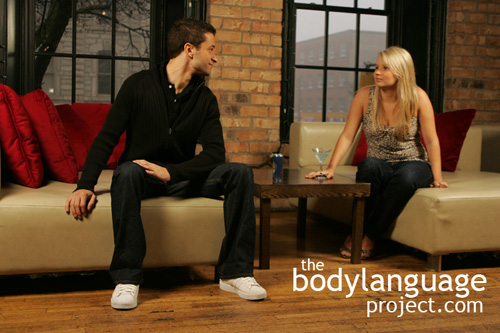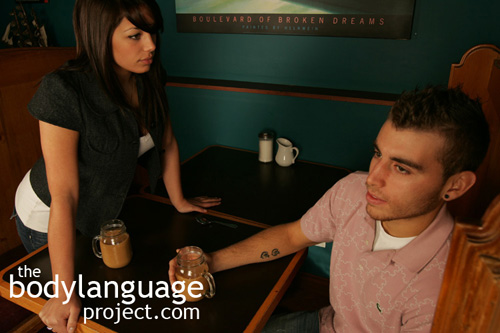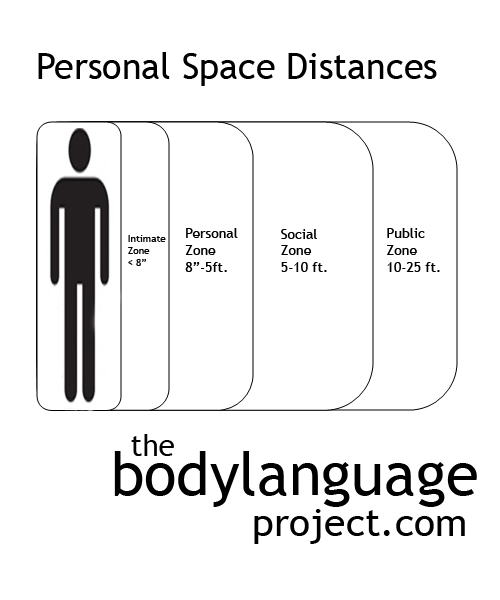
When the chest is turned away, this is called “ventral denial.” It says, “I don’t like what you’re saying.”
Torsos house important organs that are vital to keeping us alive. Our heart, lungs, liver, intestines and so forth are all easily accessible through a thin layer of skin, fat, muscle and sometimes ribs and a sternum although even these have spaces by which damage may be inflicted. Exposing our ventral side means that we trust we won’t be attacked. Laying on our backs is something we do only in our own houses because it exposes our bodies to attack and paralyzes us from defending ourselves.
Women, in the wrong company will feel particularly sensitive about exposing their breasts and both sexes will avoid displaying their genitals when nervous or timid. This is where arm and leg crossing is prevalent creating shields so as to reduce threatening exposure. Other times, bodies may turn away from people with whom we lack trust, or we may distance our torsos to give us a time and space buffer so that if a threat should be advanced, we have enough of a cushion to escape.
When in conversation people will orient their ventral side to those they trust the most and away from those they trust least. They’ll also favour those with whom they agree with most and away from people they disagree with or have contempt for. People can be seen changing their orientation more and more over the course of a conversation as ideas diverge. In dating, as women are turned off by an approach they will first shift their feet toward the exit, followed by the torso. If they wish to remain polite so as not to offend, they might keep their faces oriented toward their solicitor, yet the rest of their body, the important parts, will face away. Even slight disagreement can produce ventral shifts as bodies orient away from the speaker based on topics of lessor interest or topics we wish not do discuss.
Ventral distancing is also a nonverbal cue that indicates agreement. When people don’t like what they are hearing, they will slouch or lean backward to indicate that they aren’t seeing eye-to-eye on matters. On the other hand, when people agree, they will move toward each other to shrink the distance. When presenting a lecture, it’s easy to measure audience interest because those most keen will be sitting “at the edge of their seat” hanging onto every word. The bored or disinterested will be slouching or sitting low in their seats perhaps awkwardly to one side as if ready to take flight.
When we are reunited with loved ones we take part in hugs which is intimate precisely because the torsos are sandwiched together. We even move our arms away from our fronts so that we can get even closer. Children love to receive “raspberries” where air is blown onto their stomachs and will permit it because they trust their parents or family members. However, even with children they’ll “turn their backs on us” when they are upset with us as we enforce rules. This is a nonverbal way to show disagreement. Lovers in deep conversations will move closer to each other and face head on indicating a trust and showing no desire to leave or exit the situation which might happen by turning the torso away. Orienting the torso forward says that this is the direction in which someone is thinking about moving and when lovers do this, it means they wish to move into one another; to kiss. In a business context, people who agree with turn their bodies so they more closely face each other, even while sitting, and away from those whom they disagree with. This is called “ventral fronting” or “ventral denial.”
To use ventral language best, lean forward and drop the arms to the side when you wish to project agreement but when the opposite is desired feel free to side back in a chair or lean back or turn to the side and cross the arms. Making friends with all people is not always desirable especially when someone is malicious and unpopular. Being courteous all the time, to all people is a misuse of proper body language so use the nonverbal language that is most appropriate for the feelings you want to convey.





